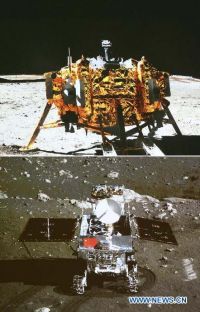Lunar Exploration Program
China's Lunar Exploration Program (CLEP) (中国探月工程), also known as the Chang'e Program, is a program of robotic and human missions to the Moon undertaken by the China National Space Administration (CNSA).
As early as in 1994, Chinese space scientists began to study the possibility of lunar exploration. In 1996, they had completed the technical program of the lunar exploration satellite, solved key technological problems by 1998 and put together the three-stage plan of "Orbiting, Landing and Returning" in 2004.
Program structure
Phase I: Orbital mission (Chang'e 1 & 2)
Chang'e 1 was successfully launched on October 24, 2007.
Chang'e 2 was successfully launched on October 1, 2010.
The launch of the Chang'e I lunar satellite represented the first phase of the project for probing the surface environment, geomorphological structure, terrain, geological structure and physical field of the moon.
Sending back the first full map of the moon's surface to China one month after its launch, the satellite ended its 16-month mission on March 1, 2009 when it hit the lunar surface at 1.50 degrees south latitude and 52.36 degrees east longitude.
Chang'e I satellite boasts 12 technological innovations.
Phase II: Soft lander (Chang'e 3)
Chang'e 3, the spacecraft carrying China's rover to the moon, was successfully launched on December 2, 2013.
Phase III: Return Mission
The "Returning" part of the plan is scheduled to be accomplished in 2017. In the meantime, the relevant departments are researching deep space probe possibilities in the future, including a landing on the Mars and other minor planets.
Timeline of China's Lunar Program
- 1998 - Commission for Science, Technology and Industry for National Defense (COSTIND) begins planning the lunar mission, tackling major scientific and technological problems;
- Jan. 2014 - lunar orbiter project is formally established;
- Feb. - mission is named "Project Chang'e" after a mythical Chinese goddess who flew to the moon;
- Oct. 24, 2007 - Chang'e 1 is successfully launched;
- Nov. 7 -Chang'e 1 enters lunar orbit;
- Nov. 26 - a clip of the voice of the probe and a Chinese song "Ode to the Motherland" are sent back from orbit. China's first picture of the lunar surface is published by Xinhua News Agency;
- Jan. 31, 2008 - COSTIND publishes the first picture of the lunar polar region taken by Chang'e 1;
- Oct. - the State Council, China's Cabinet, approves the Chang'e 2 mission;
- Nov. 12 - based on data collected by Chang'e 1, the first lunar hologram with a resolution of 7 meters is published;
- March 1, 2009 - Chang'e 1 impacts the moon under control;
- Oct. 1, 2010 - Chang'e 2 is sent into space aboard a Long March 3C carrier rocket from southwest China's Xichang satellite launch center;
- Oct. 9 - Chang'e 2 enters 100-km circular lunar orbit;
- Oct. 26 - Chang'e 2 enters lower, elliptical orbit; prepares to photograph Sinus Iridium;
- Oct. 29 - Chang'e 2 photographs Sinus Iridium and returns to a higher orbit;
- Nov. 8 - pictures of Sinus Iridium published by the State Administration for Science, Technology and Industry for National Defence (SASTIND);
- April 1, 2011 - Chang'e 2 completes all six engineering objectives and four scientific missions. Its design lifetime expires;
- April 1 - May 31 - Chang'e 2 surveys south and north poles of the moon, and takes high-resolution pictures of the chosen landing site for Chang'e 3;
- Aug. 25 - For the first time in history, from lunar orbit a space craft enters the second Lagrange Point (L2) orbit, where gravity of the sun and Earth balance the orbital motion of the satellite;
- Feb. 6, 2012 - SASTIND publishes a lunar hologram with a resolution of 7 meters;
- Dec. 13 - Chang'e 2 arrives in deep space 7 million km away from Earth, and surveys the Tout asteroid;
- Dec. 2, 2013 - Chang'e 3 is successfully launched.
- Dec. 10 - Chang'e 3 descends from a 100 kilometer-high lunar orbit at 9:20 p.m. to an elliptical orbit with its nearest point, just 15 kilometers from the moon's surface.
- Dec. 14 - Chang'e 3, with the moon rover Yutu onboard, successfully lands on the moon.
- Dec. 15 - Chang'e 3's components, the moon rover and lander, take photos of each other on the moon's surface.
- 2017 - The lunar probe Chang'e 5 is scheduled to be launched.

